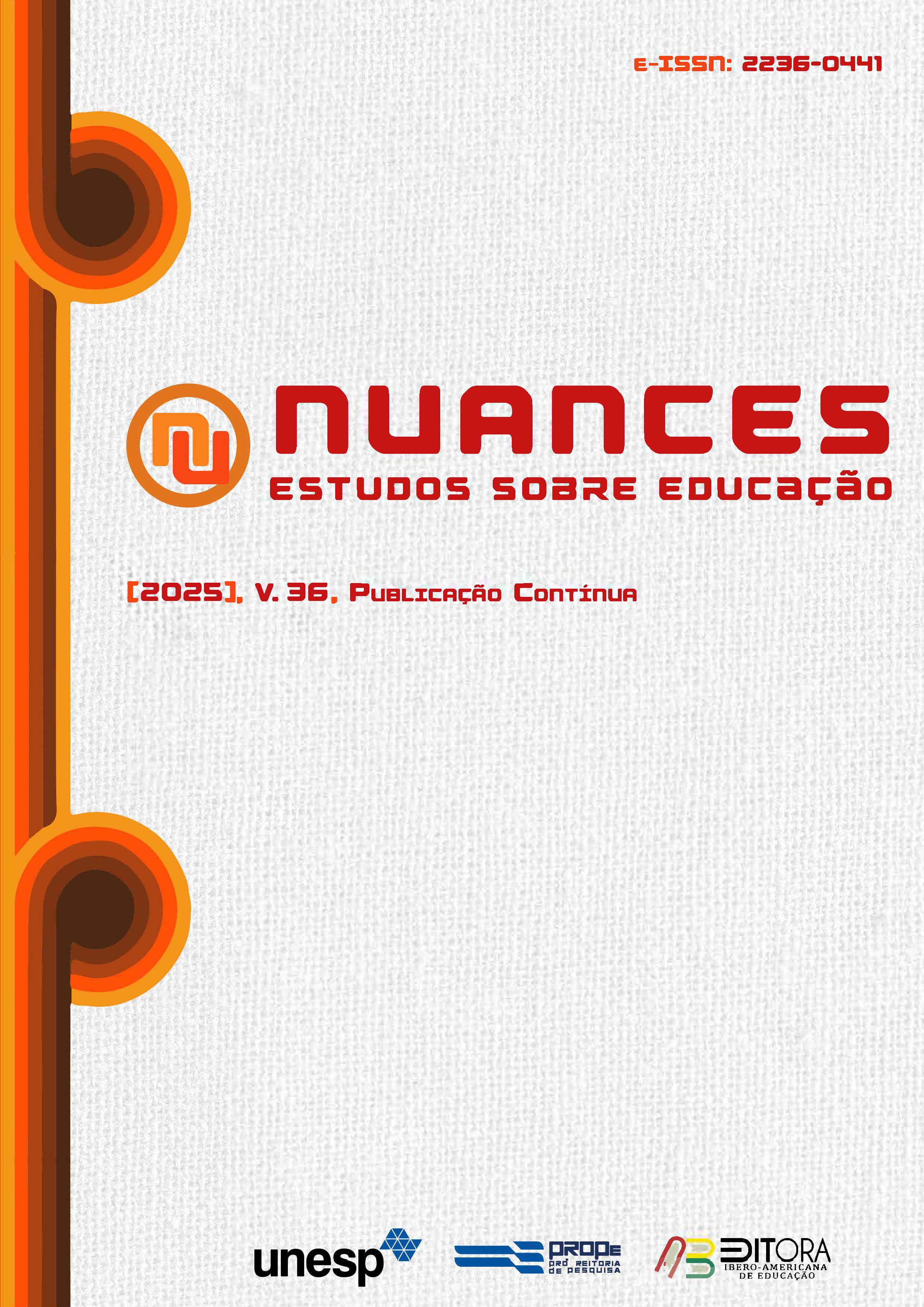Cultural adaptation and validity evidence of the imagination, creativity, and innovation (ICI) scale for use in Brazilian Portuguese – version for teachers
DOI:
https://doi.org/10.32930/nuances.v36i00.10881Keywords:
Cultural Adaptation, Creativity, Imagination, Innovation, TeachersAbstract
This study aimed to perform the cultural adaptation and validation of the Imagination, Creativity, and Innovation (ICI) scale for use in Brazilian Portuguese. The cultural adaptation process followed the COSMIN methodology, which includes five steps: 1) translation of the original instrument into Portuguese; 2) synthesis of the translations; 3) back-translation into the original language; 4) formation of a committee composed of translators, linguists, and experts in the field to produce the pre-final version of the instrument; 5) application of the final version of the inventory to a sample of 191 teachers. The version showed satisfactory reliability values, with a Cronbach's Alpha of 0.886 and McDonald's Omega of 0.882. In the confirmatory factor analysis (CFA), the items demonstrated acceptable factor loadings. Therefore, the Brazilian version of the ICI for teachers constitutes a relevant and reliable tool for analyzing creativity, imagination, and innovation in the school environment.
Downloads
References
ALENCAR, Eunice M. L. Soriano de; FLEITH, Denise de Souza. Contribuições teóricas recentes ao estudo da criatividade. Psicologia: Teoria e Pesquisa, Brasília, v. 19, n. 1, 2003. DOI: 10.1590/S0102-37722003000100002. Disponível em: https://www.scielo.br/j/ptp/a/Bw5kHpvyCYwFPsfxM7n5FMp. Acesso em: 19 jan. 2024.
BROWN, Timothy A. Confirmatory factor analysis for applied research. New York: The Guilford Press, 2015. (Methodology in the social sciences.). v. 2.
DISTEFANO, Christine; MORGAN, Grant B. A Comparison of Diagonal Weighted Least Squares Robust Estimation Techniques for Ordinal Data. Structural Equation Modeling, [s. l.], v. 21, n. 3, p. 425-438, 2014.
GADERMANN, Anne M. et al. Comorbidity and disease burden in the national comorbidity survey replication (NCS-R). Depression and Anxiety, [s. l.], v. 29, n. 9, p. 797-806, 2012. DOI: 10.1002/da.21924. Disponível em: https://pubmed.ncbi.nlm.nih.gov/22585578/. Acesso em: 19 jun. 2024.
LI, Cheng Hsien. Confirmatory factor analysis with ordinal data: Comparing robust maximum likelihood and diagonally weighted least squares. Behavior Research Methods, [s. l.], v. 48, n. 3, p. 936–949, 2016. Disponível em: https://link.springer.com/article/10.3758/s13428-015-0619-7. Acesso em: 19 dez. 2024.
MOKKINK, Lidwine B et al. COSMIN checklist manual. Amsterdam: Cosmin, 2012.
NAKANO, Tatiana de Cássia. Investigando a criatividade junto a professores: pesquisas brasileiras. Revista Semestral da Associação Brasileira de Psicologia Escolar e Educacional, São Paulo, v. 13, n. 1, p. 45-53, 2009. DOI: 10.1590/S1413-85572009000100006. Disponível em: https://www.scielo.br/j/pee/a/VbHTJbzJgMV7LHzF6Hy45Bn. Acesso em: 19 dez. 2024.
NAKANO, Tatiana Cassia; FUSARO, Luana Hillary; BATAGIN, Laís Rovina. Criatividade: percurso das pesquisas na temática. Iberoamerican Journal of Creativity and Innovation, Campinas, v. 1, n. 2, p. 89-106, 2020. Disponível em: https://recriai.emnuvens.com.br/revista/article/view/39. Acesso em: 7 ago. 2024.
NEVES-PEREIRA, Mônica Souza; ALENCAR, Eunice Maria Lima Soriano. A educação no século XXI e o seu papel na promoção da criatividade. [s. l.], v. 1, n. 1, 2018.
NÓVOA, A. Escolas e professores proteger, transformar, valorizar. Salvador: SEC/IAT, 2022.
NUNNALLY, J.; BERNSTEIN, I. Psychometric theory. New York: McGraw-Hill, 1994.
OLIVEIRA, Zélia Maria Freire de. Fatores influentes no desenvolvimento do potencial criativo. Estudos de Psicologia, Campinas, v. 27, n. 1, 2010. DOI: 10.1590/S0103-166X2010000100010. Disponível em: https://www.scielo.br/j/estpsi/a/YhfMj9CLJcmFZPg7qL9Cnky. Acesso em: 19 out 2023.
RAYKOV, Tenko; HANCOCK, Gregory R. Examining change in maximal reliability for multiple-component measuring instruments. British Journal of Mathematical and Statistical Psychology, [s. l.], v. 58, n. 1, p. 65-82, 2005. DOI: 10.1348/000711005X38753. Disponível em: https://pubmed.ncbi.nlm.nih.gov/15969840. Acesso em: 19 out 2023
RENZULLI, Joseph et al. Development of an instrument to measure opportunities for imagination, creativity, and innovation (ICI) in schools. Gifted Education International, [s. l.], v. 38, n. 2, p. 174–193, 2022.
RENZULLI, Joseph. Modelo de enriquecimento para toda a escola: um plano abrangente para o desenvolvimento de talentos e superdotação. Revista Educação Especial, Santa Maria, v. 27, n. 50, p. 539–562, 2014. DOI: 10.5902/1984686X14676. Disponível em: https://periodicos.ufsm.br/educacaoespecial/article/view/14676. Acesso em: 13 mar. 2025.
ROBINSON, Ken; ARONICA, Lou. Escolas criativas: a revolução que está transformando a educação. Porto Alegre: Penso, 2019.
SANTOS, Marcel Oliveira dos et al. Adaptação cultural e evidências de validade da escala Imagination, Criativity and Innovation (ICI) para uso na língua portuguesa do Brasil. Revista @mbienteeducação, São Paulo, v. 17, n. 00, p. e023034, 2024. DOI: 10.26843/ae.v17i00.1386. Disponível em: https://publicacoes.unicid.edu.br/ambienteeducacao/article/view/1386. Acesso em: 13 mar. 2024.
ŞIMŞEK, Gülhayat Gölbaşi; NOYAN, Fatma. McDonald’s ω t, Cronbach’s α, and Generalized θ for Composite Reliability of Common Factors Structures . Communications in Statistics - Simulation and Computation, [s. l.], v. 42, n. 9, p. 2008-2025, 2013.
TORRANCE, Ellis Paul. Criatividade: medidas, testes e avaliações. São Paulo: IBRASA, 1976.
ZINBARG, Richard E. et al. Estimating generalizability to a latent variable common to all of a scale’s indicators: A comparison of estimators for ω h. Applied Psychological Measurement, [s. l.], v. 30, n. 2, p. 121–144, 2006.
Downloads
Published
How to Cite
Issue
Section
License
Copyright (c) 2025 Nuances: estudos sobre Educação

This work is licensed under a Creative Commons Attribution-NonCommercial 4.0 International License.
Atribuição-NãoComercial
CC BY-NC
Esta licença permite que outros remixem, adaptem e criem a partir do seu trabalho para fins não comerciais, e embora os novos trabalhos tenham de lhe atribuir o devido crédito e não possam ser usados para fins comerciais, os usuários não têm de licenciar esses trabalhos derivados sob os mesmos termos.





